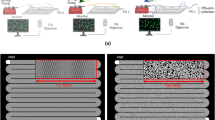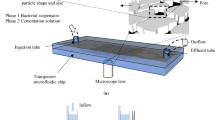Abstract
Microbially induced carbonate precipitation (MICP) involves a series of bio-geochemical reactions whereby microbes alter the surrounding aqueous environment and induce calcium carbonate precipitation. MICP has a broad range of applications, including in situ soil stabilization. However, the reliability of this process is dependent on a number of environmental conditions. In particular, bacterial growth, urease activity and precipitation kinetics all depend on temperature. Batch test and microfluidic chip experiments were performed in this study to investigate the effects of temperature on bacterial density and activity and the MICP processes occurring at different temperatures (4–50 °C). Spatial and temporal variations in the formation and development of calcium carbonate precipitates, including their amount, type, growth rate, formation and deformation characteristics, were monitored. Results show that different types of calcium carbonate precipitates with varying sizes and quantities were produced by varying the temperature. Low temperature (4 °C) did not reduce urease activity, but limited the final amount of cementation; low temperature reduced bacterial growth and attachment ratio, as well as calcium carbonate precipitation rate. High-temperature (50 °C) conditions significantly reduced urease activity within a short period of time, while a repeated injection of bacteria before every two injections of cementation solution increased the final amount of cementation. The findings made from this paper provide insight into how MICP processes vary across a range of temperatures and could be valuable for optimizing the MICP process for different applications.














Similar content being viewed by others
Data availability
All data generated or analyzed during this study are included in this published article.
Abbreviations
- MICP:
-
Microbially induced carbonate precipitation
- BS:
-
Bacterial suspension
- CS:
-
Cementation solution
- YE:
-
Yeast extract
References
Achal V, Pan X, Zhang D (2011) Remediation of copper-contaminated soil by Kocuria flava CR1, based on microbially induced calcite precipitation. Ecol Eng 37:1601–1605. https://doi.org/10.1016/j.ecoleng.2011.06.008
Al Qabany A, Soga K (2013) Effect of chemical treatment used in MICP on engineering properties of cemented soils. Géotechnique 63(4):331–339. https://doi.org/10.1680/geot.SIP13.P.022
American Society for testing and materials, standard test methods for electrical conductivity and resistivity of water, D1125–D1195
Bachmeier KL, Williams AE, Warmington JR, Bang SS (2002) Urease activity in microbiologically-induced calcite precipitation. J Biotechnol 93(2):171–181. https://doi.org/10.1016/S0168-1656(01)00393-5
Barron JJ, Ashton C (2005) The effect of temperature on conductivity measurement, TSP, knowledge.reagecon.com
Changnon SA (1999) A rare long record of deep soil temperatures defines temporal temperature changes and an urban heat island. Clim Change 42(3):531–538. https://doi.org/10.1023/a:1005453217967
Cheng L, Cord-Ruwisch R (2014) Upscaling effects of soil improvement by microbially induced calcite precipitation by surface percolation. Geomicrobiol J 31(5):396–406
Cheng L, Shahin MA, Mujah D (2017) Influence of key environmental conditions on microbially induced cementation for soil stabilization. J Geotech Geoenviron Eng 143(1):04016083. https://doi.org/10.1061/(asce)gt.1943-5606.0001586
Chow TT, Long H, Mok HY, Li KW (2011) Estimation of soil temperature profile in Hong Kong from climatic variables. Energy Build 43(12):3568–3575. https://doi.org/10.1016/j.enbuild.2011.09.026
Chu DH, Vinoba M, Bhagiyalakshmi M, Hyun Baek I, Nam SC, Yoon Y, Jeong SK (2013) CO232 system. RSC Adv 3(44):21722. https://doi.org/10.1039/c3ra44007a
Cöelfen H, Antonietti M (2008) Mesocrystals and nonclassical crystallization. Wiley, Hoboken
DeJong JT, Mortensen BM, Martinez BC, Nelson DC (2010) Bio-mediated soil improvement. Ecol Eng 36(2):197–210
Dinghua P, Suyu Q, Yao L, Hang Ma, Lei Z, Hou Siyu Wu, Heng BX (2020) Performance of microbial induced carbonate precipitation for immobilizing Cd in water and soil. J Hazard Mater 400:123116
Dunne WM (2002) Bacterial adhesion: seen any good biofilms lately? Clin Microbiol Rev 15(2):155–166
Dupraz S, Parmentier M, Ménez B, Guyot F (2009) Experimental and numerical modeling of bacterially induced pH increase and calcite precipitation in saline aquifers. Chem Geol 265(1–2):44–53
Fathima F, Jayalakshmi S (2012) Characterization of urease enzyme from marine bacterium Klebsiella species. Afr J Microbiol Res 6:5914–5923
Ferris FG, Phoenix V, Fujita Y (2004) Kinetics of calcite precipitation induced by ureolytic bacteria at 10 to 20 °C in artificial groundwater. Geochim Cosmochim Acta 68(8):1701–1710
Gao Z, Bian L, Hu Y, Wang L, Fan J (2007) Determination of soil temperature in an arid region. J Arid Environ 71(2):157–168
Green FHW, Harding RJ (1980) Altitudinal gradients of soil temperatures in Europe. Trans Inst Br Geogr 5(2):243–254
Han P, Geng W, Li M, Jia S, Yin J, Xue R (2021) Improvement of biomineralization of sporosarcina pasteurii as biocementing material for concrete repair by atmospheric and room temperature plasma mutagenesis and response surface methodology. J Microbiol Biotechnol 31(9):1311–1322
Hataf N, Baharifard A (2020) Reducing soil permeability using microbial induced carbonate precipitation (MICP) method: a case study of shiraz landfill soil. Geomicrobiol J 37(2):147–158. https://doi.org/10.1080/01490451.2019.1678703
Khan YM, Munir H, Anwar Z (2019) Optimization of process variables for enhanced production of urease by indigenous Aspergillus niger strains through response surface methodology. Biocatal Agric Biotechnol 20(April):101202
Koh CA, Westacott RE, Zhang W, Hirachand K, Creek JL, Soper AK (2002) Mechanisms of gas hydrate formation and inhibition. Fluid Phase Equilib 194:143–151
Kralj D, Brečević L, Kontrec J (1997) Vaterite growth and dissolution in aqueous solution III. Kinetics of transformation. J Crys Growth 177(3–4):248–257
Mitchell AC, Phillips AJ, Hiebert R (2009) Biofilm enhanced geologic sequestration of supercritical CO2. Int J Greenhouse Gas Control 3(1):90–99
Mortensen BM, Haber MJ, DeJong JT (2011) Effects of environmental factors on microbial induced calcium carbonate precipitation. J Appl Microbiol 111(2):338–349
Nemati M, Voordouw G (2003) Modification of porous media permeability, using calcium carbonate produced enzymatically in situ. Enzyme Microb Technol 33:635–642
Ning-Jun J, Liu Rui Du, Yan-Jun B-Z (2019) Microbial induced carbonate precipitation for immobilizing Pb contaminants: toxic effects on urease activity and immobilization efficiency. Sci Total Environ 672:722–731. https://doi.org/10.1016/j.scitotenv.2019.03.294
van Paassen LA, Ghose R, van der Linden Thomas JM, van der Star Wouter RL, van Loosdrecht Mark CM (2010) Quantifying biomediated ground improvement by ureolysis: large-scale biogrout experiment. J Geotech Geoenviron Eng 136(2):1721–1728
Peltzer ET, Brewer PG (2000) Practical physical chemistry and empirical predictions of methane hydrate stability. Natural Gas Hydrate. Springer, Dordrecht, pp 17–28
Peng J, Liu Z (2019) Influence of temperature on microbially induced calcium carbonate precipitation for soil treatment. PLoS ONE 14(6):e0218396
Sagidullin AK, Stoporev AS, Manakov AY (2019) Effect of temperature on the rate of methane hydrate nucleation in water-in-crude oil emulsion. Energy Fuels 33(4):3155–3161
Stocks-Fischer S, Galinat JK, Bang S (1999) Microbiological precipitation of CaCO3. Soil Biological Biochemistry 31(11):1563–1571
Sun X, Miao L, Tong T, Wang C (2018) Study of the effect of temperature on microbially induced carbonate precipitation. Acta Geotech 14(3):627–638
Wang Y, Konstantinou C, Soga K, Biscontin G, Kabla AJ (2022) Use of microfluidic experiments to optimize MICP treatment protocols for effective strength enhancement of MICP-treated sandy soils. Acta Geotech. https://doi.org/10.1007/s11440-022-01478-9
Wang Y, Soga K, DeJong JT, Kabla AJ (2019) Microscale visualization of microbial-induced calcium carbonate precipitation processes. J Geotech Geoenviron Eng 145(9):04019045
Wang Y, Soga K, DeJong JT, Kabla AJ (2021) Effects of bacterial density on growth rate and characteristics of microbial-induced CaCO3 precipitates: particle-scale experimental study. J Geotech Geoenviron Eng 147(6):04021036
Wang Y, Soga K, Dejong JT, Kabla AJ (2019) A microfluidic chip and its use in characterising the particle-scale behaviour of microbial-induced calcium carbonate precipitation (MICP). Géotechnique 69(12):1086–1094
Wang Y, Soga K, Jiang NJ (2017) Microbial induced carbonate precipitation (MICP): the case for microscale perspective. In Proceedings of the 19th international conference on soil mechanics and geotechnical engineering, pp. 1099–1102
Whiffin VS, van Paassen LA, Harkes MP (2007) Microbial carbonate precipitation as a soil improvement technique. Geomicrobiol J 24(5):417–423
Whiffin VS (2004) Microbial CaCO3 precipitation for the production of biocement (Doctoral dissertation, Murdoch University)
Wu L, Zhang J (2014) Strong subsurface soil temperature feedbacks on summer climate variability over the arid/semi-arid regions of East Asia. Atmosp Sci Lett 15(4):307–313
Xiao Y, He X, Wu W, Stuedlein AW, Evans TM, Chu J, Hanlong LH, van Paassen LA, Wu H (2021) Kinetic biomineralization through microfluidic chip tests. Acta Geotech 16:3229–3237
Xiao Y, He X, Stuedlein AW, Chu JT, Evans TM, van Paassen LA (2022) Crystal Growth of MICP through Microfluidic Chip Tests. J. Geotech. Geoenviron. Eng., 2022, 148(5): 06022002
Zhang W, Ju Y, Zong Y, Qi H, Zhao K (2018) In situ real-time study on dynamics of microbially induced calcium carbonate precipitation at a single-cell level. Environ Sci Technol 52(16):9266–9276
Zhao Q (2014) Experimental study on soil improvement using Microbial Induced Calcite Precipitation (MICP). Beijing: China University of Geoscience (Beijing)
Acknowledgements
Y.W. acknowledges the financial support of Natural Science Foundation of China (Grant Nos. 52171262, 42141003), Science and Technology Innovation Committee of Shenzhen (Grant No. JCYJ20210324103812033) and Shenzhen Key Laboratory of Natural Gas Hydrates (Grant No. ZDSYS20200421111201738) for conducting this study. The authors acknowledge Dr. Fedir Kiskin for proof reading the manuscript.
Author information
Authors and Affiliations
Contributions
The manuscript was written through contributions of all authors. All authors have given approval to the final version of the manuscript.
Corresponding author
Additional information
Publisher's Note
Springer Nature remains neutral with regard to jurisdictional claims in published maps and institutional affiliations.
Rights and permissions
Springer Nature or its licensor holds exclusive rights to this article under a publishing agreement with the author(s) or other rightsholder(s); author self-archiving of the accepted manuscript version of this article is solely governed by the terms of such publishing agreement and applicable law.
About this article
Cite this article
Wang, Y., Wang, Y., Soga, K. et al. Microscale investigations of temperature-dependent microbially induced carbonate precipitation (MICP) in the temperature range 4–50 °C. Acta Geotech. 18, 2239–2261 (2023). https://doi.org/10.1007/s11440-022-01664-9
Received:
Accepted:
Published:
Issue Date:
DOI: https://doi.org/10.1007/s11440-022-01664-9




